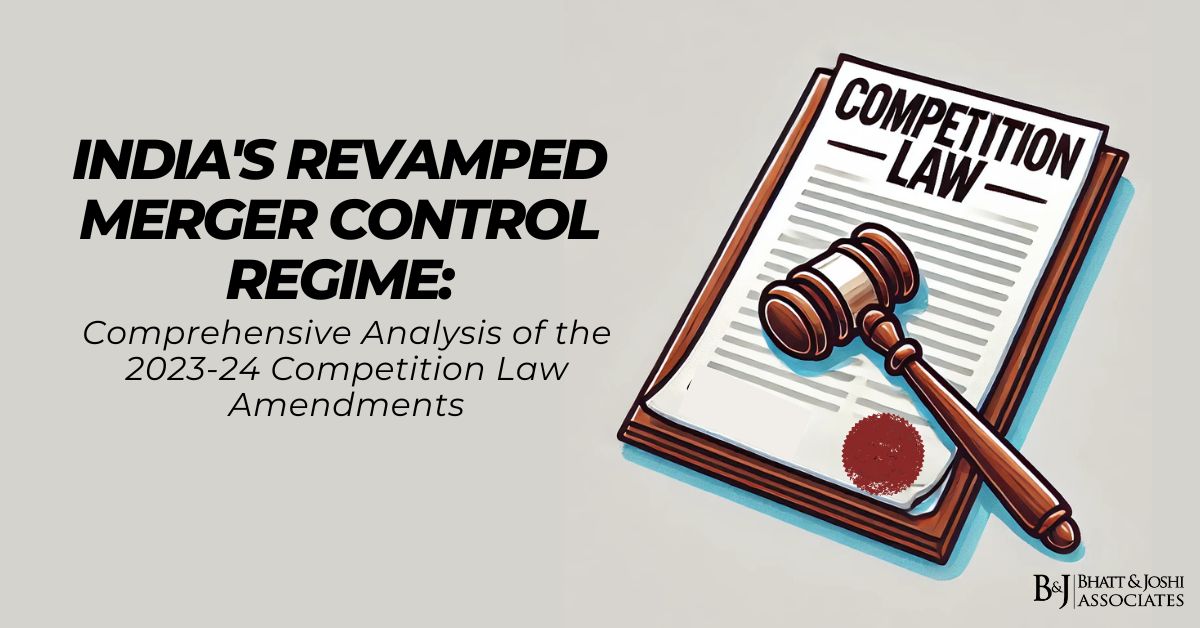Introduction
The recent overhaul of India’s competition law framework represents one of the most significant regulatory shifts in the country’s business landscape. The Indian Merger Control Regime Revamped through the Competition (Amendment) Act, 2023, and the subsequent Competition Commission of India (Combination) Regulations, 2024, has fundamentally transformed to address modern market dynamics and align with global best practices.
Introduction: India’s Competition Law Evolution
India’s competition law framework has undergone a dramatic transformation since the Competition Act, 2002 first came into force. The merger control provisions, enforced since June 2011, have witnessed the Competition Commission of India (CCI) processing nearly 990 merger notifications without blocking any transactions outright. Instead, in approximately 23 cases where competition concerns were identified, the CCI imposed remedies to mitigate potential anti-competitive effects.
The latest amendments, however, mark a watershed moment in this evolution. The Competition (Amendment) Act, 2023 (“Competition Amendment Act”) received presidential assent in April 2023, introducing significant changes to enhance the regulator’s effectiveness while streamlining procedural aspects. These amendments were implemented in September 2024 along with the Competition Commission of India (Combination) Regulations, 2024 (“Revised Combination Regulations”), replacing the previous framework established in 2011.
Key Transformative Changes in Indian Merger Control Regime Framework
- Deal Value Threshold: A Paradigm Shift
Perhaps the most consequential change is the introduction of the Deal Value Threshold (DVT), which came into effect on September 10, 2024. This provision requires notification of transactions valued above INR 2,000 crore (approximately US$238 million) where the target has “substantial business operations” in India.
The DVT concept represents a fundamental shift from the traditional asset and turnover-based thresholds that previously determined notification requirements. This addition specifically aims to capture transactions in the digital economy and other sectors where targets may have significant market impact despite limited revenue or assets.
- Control Definition Expanded: Introducing “Material Influence”
The Competition Amendment Act has codified the concept of “material influence” within the definition of “control”. This expanded definition aligns with the CCI’s decisional practice and captures a broader spectrum of influence scenarios, including:
- Factors giving an enterprise the ability to influence the management and affairs of another entity
- Shareholding structures
- Special rights
- Board representation
- Structural and financial arrangements
- Status and expertise of influential stakeholders
This expanded definition means that even minority acquisitions conferring significant influence may trigger notification requirements, marking a critical consideration for investment structures.
- Procedural Timeline Compression
The amendments have substantially compressed the merger review timeline:
- Overall review period reduced from 210 to 150 days from notification
- Time for CCI to form a prima facie opinion reduced from 30 working days to 30 calendar days
While these shortened timelines aim to expedite approvals, they also create potential challenges for both the CCI and notifying parties:
- Increased likelihood of information requests leading to “clock stops”
- Possibility of mandatory pre-filing consultations
- Greater pressure on the CCI’s resources, particularly with the expected increase in notifications due to the DVT
- Green Channel Approvals: Codification of Fast-Track Clearance
The amendments have codified the “green channel” approval route introduced in 2019 by inserting Regulation 5A into the Combination Regulations. This process enables automatic approval for combinations where parties have:
- No horizontal overlaps
- No vertical relationships
- No complementary business activities
Similar to Israel’s “Bright Green” route, this process expedites approval for transactions unlikely to raise competitive concerns, enabling parties to implement combinations immediately upon filing.
The 2024 Revised Combination Regulations: Operationalizing the Framework
Building upon the Competition Amendment Act, the CCI released the Revised Combination Regulations in September 2024 after extensive stakeholder consultation. These regulations provide the operational framework for implementing the legislative changes, addressing critical aspects such as:
De Minimis Thresholds Codification
The Revised Combination Regulations incorporate the de minimis thresholds from the Ministry of Corporate Affairs notification dated March 7, 2024. This exemption excludes smaller transactions from mandatory notification, balancing regulatory oversight with business efficiency.
Implementation of Open Offers
The new regime permits implementation of open offers and acquisition of convertible securities prior to CCI approval, subject to:
- Proper notification to the CCI
- Restrictions on exercising ownership rights, beneficial rights, or voting rights
- Prohibition on receiving dividends or other distributions until approval
Furthermore, the regulations clarify permissible pre-approval actions, including:
- Availing economic benefits such as dividends, rights issues, bonus shares, stock splits, and share buybacks
- Exercising voting rights in matters related to liquidation or insolvency proceedings
Filing Fees Increase
The Revised Combination Regulations have increased filing fees:
- Form I filings: from INR 20 lakhs to INR 30 lakhs (approximately US$24,000 to US$36,000)
- Form II filings: from INR 65 lakhs to INR 75 lakhs (approximately US$78,000 to US$90,000)
These increases reflect the expanded scope and complexity of the merger review process under the new regime.
International Comparison: India’s Position in Global Merger Control Regime
European Union Approach
The EU merger control regime, while not employing a formal deal value threshold, has been increasingly aggressive in enforcing gun-jumping violations, with €113.8 million in fines imposed across 70 decisions in 2022 alone. Notable cases include:
- Canon Inc. vs. European Commission (2022): €28 million fine for implementing a transaction through an interim structure before approval
- Altice Europe vs. Commission (2021): €124.5 million penalty for failing to notify and comply with standstill obligations
India’s approach, particularly with its clear DVT threshold, provides greater certainty than the EU’s more discretionary approach to capturing significant transactions.
United States Framework
The US merger control system, administered by the Federal Trade Commission (FTC) and Department of Justice (DOJ), rigorously enforces the Hart-Scott-Rodino Act’s waiting periods and the Sherman Act’s prohibitions against pre-consummation coordination. Key US cases include:
- United States vs. Gemstar-TV Guide International (2003): $5.676 million penalty for premature alignment of economic interests during negotiations
- In re Insilco Corp.: Violations found for illegal information exchange between competitors during pre-consummation period
India’s regime now more closely resembles the US system’s strict approach to gun-jumping, with clear prohibitions against premature implementation.
Israel’s Approach
Israel’s merger control regime under the Economic Competition Law 5748-1988 features a “Bright Green” route similar to India’s green channel, enabling expedited approval for transactions raising no competitive concerns. The Israel Antitrust Authority (IAA) has enforced gun-jumping violations in cases like the Michlol-Berman Merger and Imagine Media-Kardan Israel Merger, where premature integration actions were sanctioned.
India’s approach combines elements from these international regimes while adapting to its unique market characteristics.
Gun Jumping: Enhanced Scrutiny and Enforcement
Gun jumping remains a critical compliance concern under the revised framework. It refers to the premature implementation of a merger or acquisition before receiving necessary regulatory approvals. Under Indian competition law, gun jumping can include:
- Premature exchange of commercially sensitive information
- Combining resources or implementing operational changes
- Exercising control over the target’s business decisions before approval
The enhanced enforcement powers and clearer guidelines in the new regime make gun jumping violations potentially more costly for businesses. The CCI has demonstrated its willingness to impose penalties for such violations, making compliance a critical priority.
Practical Safeguards Against Gun Jumping
Companies can adopt several measures to avoid gun jumping violations:
- Implementing “antitrust protocols” in M&A agreements clearly outlining conduct during standstill periods
- Conducting thorough due diligence before entering merger agreements
- Safeguarding sensitive information through data rooms, clean teams, and non-disclosure agreements
- Ensuring the target entity continues operating in the ordinary course of business
- Maintaining open communication with competition authorities
- Implementing robust internal controls and compliance programs
Strengths and Challenges of the New Indian Merger Control Regime
Strengths
- Modernized Framework: The amendments address regulatory gaps in digital markets and non-traditional business models.
- Expedited Reviews: Shortened timelines promote business certainty and reduce transaction costs.
- Green Channel Efficiency: The codified green channel process streamlines approvals for non-problematic combinations.
- Enhanced International Alignment: The revisions bring India’s competition law closer to global best practices.
Challenges
- Resource Constraints: The CCI’s limited workforce may struggle with increased notifications due to the DVT and compressed timelines.
- Definitional Ambiguities: Terms like “substantial business operations” require clearer guidelines to ensure consistent application.
- Compliance Burden: The expanded scope increases compliance costs, particularly for cross-border transactions.
- Transition Uncertainties: Ongoing transactions that were executed but not closed must be reassessed under the new framework.
Impact on Stakeholders
For Corporates and Investors
- Enhanced Due Diligence: Greater scrutiny of transaction structures and potential competitive implications is now essential.
- Extended Transaction Timelines: Despite shorter regulatory periods, the expanded notification requirements may lengthen overall deal timelines.
- Increased Compliance Costs: More transactions will require competition assessments and potentially complex notifications.
- Structural Considerations: Deal structures may need reconfiguration to address competition concerns preemptively.
For Legal Advisors
- Expanded Advisory Role: Competition analysis must begin earlier in transaction planning.
- Deeper Economic Analysis: Particularly for transactions captured under the DVT.
- International Coordination: Cross-border transactions require harmonized approaches across multiple jurisdictions.
Conclusion: A New Era for Indian Competition Law
The revamped Indian merger control regime represents a significant maturation of the country’s competition law framework. By introducing the deal value threshold, codifying the green channel process, expanding the definition of control, and streamlining procedural timelines, India has created a more robust system aligned with global standards.
While challenges remain in implementation and interpretation, the amendments position the CCI as a more effective regulator capable of addressing modern market dynamics. For businesses, the new regime demands enhanced vigilance and strategic planning, but also offers greater clarity and potentially faster approvals for straightforward transactions.
As this framework continues to evolve through practice and interpretation, stakeholders across the business and legal spectrum must remain attentive to developments and adapt their approaches accordingly. The success of this revamped Indian merger control regime will ultimately depend on the CCI’s ability to balance effective enforcement with business facilitation – a delicate equilibrium that will shape India’s competitive landscape for years to come.
Article by : Aditya bhatt
Associate: Bhatt and Joshi Associates














